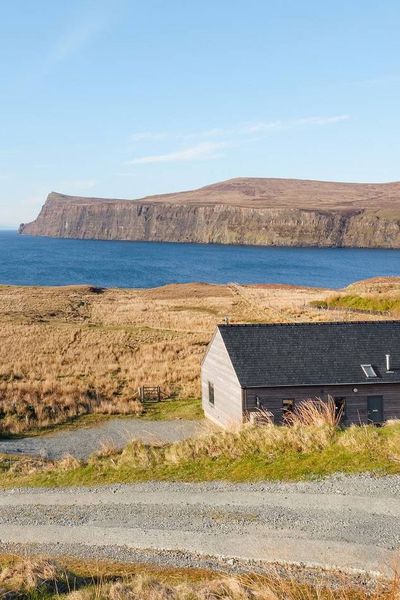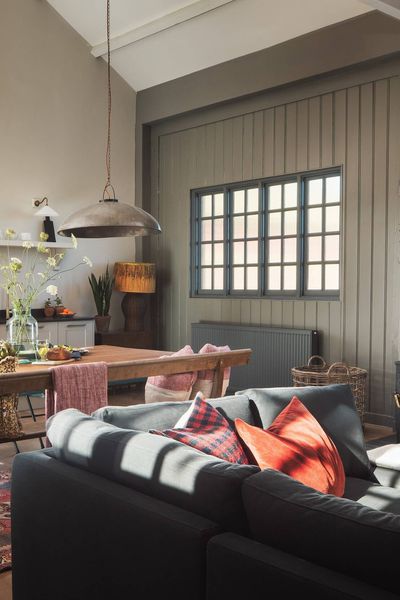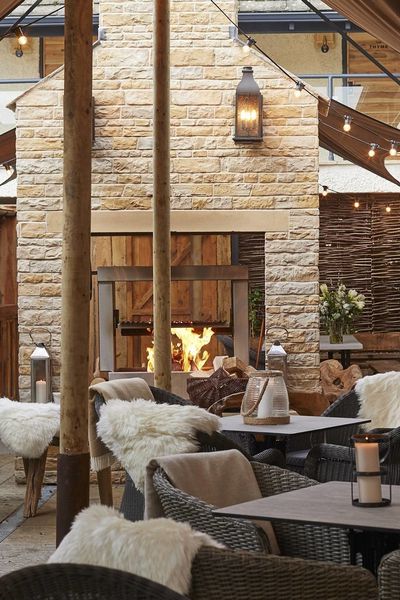
We went to Skye in anticipation of discovering wildly beautiful landscapes, exceptional food, and fantastic wildlife, but we also went with a question to answer. Was tourism good for the island? Or perhaps, how could it be good? Travel is vital to Skye’s economy, but we feared joining the hordes of people whose influx onto the island in recent years has put significant strain on its infrastructure and damaged the serene peace and natural beauty which are its key attractions.
It’s hard to resist the lure of the Fairy Pools when you visit Skye, because the images are so iconic, but Sligachan was just as beautiful and, crucially, completely deserted. Admittedly, we’d ventured out before breakfast, but the water shone silver where it caught the first light of the day, offering perfect symmetry with the frosted mountain tops, as gentle cascades threaded through an open landscape of heather and distant, solitary white houses. We lingered in the peace for a while, before heading back to reward ourselves with one of Iona and Jasper’s superb breakfasts, choosing from smoked salmon, mackerel cooked in milk, porridge and thick slices of toast covered in wild heather honey.




As well as being a warm and welcoming host, Jasper is a volunteer director of Skye Connect, which promotes sustainable travel to the island, and also the skipper of Breeze, a yacht on which he runs wildlife spotting day trips in the waters off Skye. It seemed like a wonderful idea to combine some sightseeing with a chat about the challenges of tourism, so one beautiful morning, we stepped aboard Breeze and set sail. Gliding through clear waters under a cloudless sky was simply beautiful and, over the fine lunch included in a day’s sailing, we discussed Skye Connect’s mission to spread tourism into a broader season, with longer stays and destinations outside of the Instagram hit list. Despite only seeing a few cormorants and shags, it was still one of our favourite wildlife experiences in Skye.
Explore all of our places to stay in Portree >


Elgol
We’d been keen to explore the area around Elgol, in the south of Skye, ever since a member of the team had come back from a visit with tales of superb seafood and treacle bread at the end of a long road that seemed to lead nowhere. In fact, it led to Coruisk House, a boutique hotel from which Clare Winskill and her husband Iain run Skye Fine Wines and a Michelin guide restaurant. Clare is another director of Skye Connect and also a director of the Scottish Tourism Alliance, so we headed down to sample both her wisdom and her magnificent baking.
On the way, we discovered another alternative to the Fairy Pools, at Torrin, where tumbling waterfalls ran down the banks of Loch Slapin in front of a backdrop of sharp peaks. Two teenagers were challenging each other to get into the very cold water, but despite the inviting glow of the golden on the sapphire streams, we thought it best to leave them to it. Arriving in Elgol itself, we took a walk around the harbour and stopped for home-made ice cream at Elgol Bistro. The harbour was a perfect picture of boats bobbing in still water that glowed in the late afternoon sun. They were mostly fishing boats, which we were soon to learn provided Coruisk House with much of its menu, but there was also the small sightseeing boat operated by Misty Isle Boat Trips, a family business that’s been taking visitors on tours of Loch Coruisk and the coast for over 50 years. We sat for a moment, savouring cones of fresh raspberry ripple and a tangy mandarin and Cointreau, before heading off to meet Clare.
She and Iain bought Coruisk House in 2011 and spent two years turning the old building into the elegant hotel it has now become. Even in that time, she says she has seen tourism on Skye change dramatically. She puts much of it down to social media, which has flooded the scenic spots, mostly on the north of the island, with visitors on a mission to collect Skye’s most famous images. She hopes that work like the MySkyeTime app, developed by Skye Connect and the University of Edinburgh, will encourage visitors out of busy areas by helping them plan their trip around busy periods. Eventually they hope to add restaurants to the app, and they’re also working on the Foundation for Skye, through which people would voluntarily contribute to a trust fund used towards maintenance of paths, toilets, parking and other facilities. She is a bubbling font of ideas for wild swimming spots, mountain hikes and all sorts of alternative things to do on Skye and, as with Jasper, the message is clear. Stay longer, see less, experience more.
Clare’s words on tourism were compelling, but we got an even more powerful demonstration of her commitment to the local community when we talked food. She and Iain have abandoned a la carte dining, instead offering only a set menu to their small group of diners every evening, creating a more sociable experience and allowing the food to be entirely guided by the availability of the ingredients, which come from as close to the house as possible. A forager friend, trained by the Royal Horticultural Society (RHS), is a constant source of supplies and ideas, from hawthorn leaves in soup to birch sap crème brulee and seaweed butter bread. There are spirits brought over on the ferry from Raasay, fish straight off the harbour boats and wines carefully selected by both Clare and Iain from years of touring and tasting, with a story behind every choice.
After saying our goodbyes, we wove our way back to Portree along more of Skye’s scenic roads, with our minds drifting off on rich, bold flavours and hazy ideas of walks that would never fit into our schedule.
Read five of the best walks on the Isle of Skye >




Carbost
While there are many reasons to visit Carbost, just to the south and west of Portree, we went for a very specific one – to meet a man who lives, breathes and eats the Skye countryside. Forager, bushcraft expert and guide Mitchell Partridge runs Skye Ghillie, offering tours and trips that can take you wildlife watching, fishing, fire lighting and an awful lot more. On a beautiful, sunny morning by the shores of Loch Harport We spoke to him about how his trips are as much to do with mental health as food or bushcraft, and how Skye is the perfect place for people to unwind.
“People come from London, New York, all over. I can feel their anxiety and angst when they get here. Foraging, being in this place, takes them out of that mindset. A family came recently, and the parents were so drained, I could see it. So, I focused on their girls and the parents got a chance to relax and take a minute for themselves.”
Mitchell took us down to the nearby beach to give us a taster of the foraging walks, showing us dandelion we should leave until September, when the roots could be pulled up, roasted and ground for coffee, as well as sweet sea plantain and sandwort, which he uses in salads, and the peppery horseradish-like scurvy grass. He explained how he normally takes his groups deep into Skye, where few people ever go. Like many locals, he’s concerned at the strain placed on the island’s infrastructure, especially by the profusion of camper vans in high season. He often turns down guests who enquire about summer trips to Skye’s “top 5 destinations”, urging them to come in winter, when the landscape is equally stunning and even the most famous spots are comparatively deserted.
We nibbled thoughtfully at our plants and wandered back up to the Caora Dhubh coffee shop where we’d met, to carry on our conversation. As we sat in the sun, hearing Mitch talk with such love and generosity about the joys of being outside and the experiences he wants guests to have, he stopped every few seconds to exchange a few words with a passerby. At times, we’d wondered whether living on Skye in all its beautiful remoteness might be isolating, so it was amazing to get that sense of a supportive, caring and active community in Carbost, both in Mitch’s words and his interactions with everyone who passed us. The chance to tap into such warmth and friendliness felt like another reason to slow down on Skye.




With a little time left to kill in Carbost, we made the obvious choice and raided the coffee shop and deli we’d been sitting outside for some delicious cakes, before following a local tip up the hill. We’d been told that there was an intriguing thing called an “oyster shed” to be discovered and, after a short climb past trickling waterfalls and banks of primroses, we found it. Exactly as the name suggests, the simple shack served seafood on the seashore, with a snaking queue of locals and tourists waiting to pick up all sorts of shellfish to take away or eat on site. We picked up a plate heaped with langoustine, oysters and chips, then ate off an upturned barrel, looking out over Loch Harport, marvelling again at the crisp blues of the water and sky.
Read our food and drink lover’s guide to the Isle of Skye >


Glendale
The way Mitchell has made his life from the landscape of Skye is by no means unique on the island. Artists and artisans of all sorts go there to draw on the scenery and sense of space for their creative work. In Glendale, on the north-western lobe of Skye, we met Andrea and Roger of Skye Weavers, who create incredible textiles from local wool on bike-powered looms. We dropped in to talk and soon found ourselves put to the pedals, struggling to master the even rhythm required, but glad we’d been spared the job of hooking up the 1,500 threads.
Andrea and Roger’s home, studio and shop sit in a shallow valley commanding another of Skye’s endless supply of sea views, and Andrea, who does most of the pattern design, needs nothing more to get her mind racing. One fabric was inspired by the yellow-orange lichen on rocks, another by the shapes brushed into sand by waves. She and Roger both spoke, as Mitchell had done, of their love for the place itself, but also its people. The warping mill on site was cobbled together from things found and borrowed from friends – the hinge from an old dishwasher, a tractor rake, some parts from the kit of a BT engineer. They even work with a local tanner (more on them later!) but were also keenly aware of how important tourism is in sustaining that community.
“We came here thinking we’d scrape a living somehow. It’s turned into so much more than that,” Andrea told us. “The popularity of the place can be hard to deal with when you’ve been here all your life, but in a way it’s a nice problem to have. People come here keen to understand the process and to buy. It wouldn’t be a sustainable business in many other places.”
Andrea often tests her new patterns on small, simple blankets, checking that the pattern will work within the limits of their technology before expanding it to other products. We watch as Chief Pedaller Paul takes over and the rapier whistles back and forth through the threads, hoping that Skye can find a way to integrate tourism, tradition and communities like these just as seamlessly.




Waternish
Following the thread of our chat with Andrea and Roger lead us to another success story of innovation, creativity and community on the island. Just around the corner, in Skye terms at least (it’s a half-hour drive), was Skyeskyns, the last remaining commercial tannery on the island, passed down to owner Jess Hartwell by her parents, who founded the business over 40 years ago. With years of painstaking work, Jess has transformed a chemically intense process into a remarkably sustainable one, while at the same time finding ways to make not just her own, but many other businesses on Skye more viable.
Jess talked us through the complexities of the multi-stage process of tanning, briefly getting us excited with the idea of mimosa baths, before revealing that they were a bark-based treatment for the skins, not a chance to wallow in champagne cocktails. The use of mimosa, a quick-growing sustainable alternative to chemicals, is one of the new ideas that she’s brought to the business, but in other ways she’s fighting to preserve a tradition that dates back centuries. Much of the work is done by hand, with hours of scraping, oiling and stretching going into each supple piece of hide.
The resulting products are beautiful, but one of the things Jess is most proud of making at Skyeskyns, is an impact on the community. As well as some easy wins like partnering with Skye Weavers to make lined sheepskin slippers, she set up a café in a yurt and ran a soup-based socialising scheme aimed at tackling the loneliness that living in a remote area can bring about. Perhaps most importantly, Jess’ family was part of an initiative in which several business owners in Waternish decided to open all year. The pioneering spirit of Jess’ father and other pub and business owners in the area meant that the season was lengthened, income was stabilised, and the impact of tourism was more spread out. It was a huge success and has since been taken up by many others across the island, making a stunning, wintery break on Skye a viable option.
Read why off season is the best time to visit the Isle of Skye >


We said goodbye to Jess and wandered down to dinner at The Stein Inn, the oldest pub on Skye. Its setting, right on the waterfront of a quiet bay, was magical, but The Stein doesn’t rest on its scenic laurels. We settled down to the very best meal we had on our whole trip, Scottish classics elevated with beautiful cooking and inventive flavour combinations. We dipped haggis bonbons in whisky cream, made messy work of crab served with bread, peaches, tender stem broccoli, and tarragon yoghurt, then somehow found room for a sticky toffee pudding with poppy seed caramel. It was a tasting tour of island produce, accompanied by yet another reminder of how it all hangs together – the chanterelle mushrooms had come from Mitchell at Skye Ghillie, the light, smokey whisky was from Raasay and in the corner was a dog, sleeping soundly on the soft comfort of a hand-crafted Skyeskyn rug.
Explore all of our places to stay by Waternish >


Ps… Otters
As we headed for home, we made one last detour, overshooting the bridge to the mainland to visit Kylerhea Otter Hide. At the end of a rutted, winding road (tough driving even for Skye) we parked up about a mile from the hide. The track through the trees was beautiful, with birch and spruce trees giving flickering glimpses of water and peaks as we walked, serenaded by the occasional chirrups from stonechats and wheatears. The hide was an incredibly peaceful spot that let us look across the water from all angles, as we considered everything we’d seen and heard on Skye. It also made us think about what we hadn’t seen. If we’d had more time, we might have been able to spot seals, sea eagles and even the elusive otters themselves. We could have hiked deep into the hills and watched the sun set on deserted lochs. As people had been telling us all along, what we really needed was to stay longer, move less, experience more.


View all of our places to stay on the Isle of Skye >
Want more travel inspiration? Get our email updates direct to your inbox >
Sign up >Share this article:
You might also like
Why I do it: Rachel Bucknall, owner of The Bridge Inn, The Ship and The Crusoe

Christopher Wilson-Elmes
Sawday's Expert
5 min read
Our guide to Scotland’s must-see regions

Jem Brownlee
Sawday's Expert
5 min read
Clear Skye: Why off season is the best time to visit the famous island

Christopher Wilson-Elmes
Sawday's Expert
5 min read













